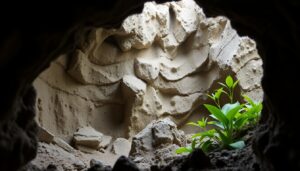Belize, celebrated for its breathtaking coral reefs and ancient Maya ruins, harbours an exceptional array of archaeological and ecological wonders lying beneath its surface. The extensive limestone cave systems have captivated scholars and adventurers alike, presenting unparalleled insights into the ancient Maya ritual life, offering detailed records of climatic changes, and revealing unique subterranean ecosystems. Recent scientific inquiries within Belize's caves have led to remarkable findings that not only enhance our comprehension of the Maya civilisation but also shed light on historical climate fluctuations, including the discovery of rare, previously unidentified cave species that contribute to the region's rich biodiversity.

1. Dive Deep into the Intriguing History of Maya Rituals Discovered in Belize's Enigmatic Caves
The captivating cave systems of Belize, including the renowned Actun Tunichil Muknal (ATM Cave), Barton Creek Cave, and Cara Blanca Caves, have yielded some of the most significant archaeological evidence concerning Maya sacrificial and ceremonial customs. These hallowed caves were perceived as gateways to the Maya underworld, known as Xibalba. Recent archaeological discoveries have profoundly enhanced our understanding of their spiritual and societal significance, revealing intricate complexities that were previously overlooked, thus enriching our appreciation of their cultural legacy.
1.1 The Groundbreaking Revelation Behind the “Crystal Maiden” Identity
The famous calcified skeleton, commonly referred to as the Crystal Maiden, discovered within ATM Cave, has traditionally been interpreted as the remains of a female sacrifice. However, cutting-edge forensic analysis has catalysed a critical reevaluation of this perspective. Through advanced isotopic and morphological investigations, results suggest that these remains likely belonged to a young male. This groundbreaking revision prompts scholars to reconsider the social and religious dynamics surrounding human sacrifices in Maya ritual practices, particularly during periods of environmental stress, such as the severe droughts experienced around the 9th century CE, illustrating the intricate relationship between ecology and culture.
1.2 Unearthing New Contexts for Maya Ritual Practices
Excavation efforts in Barton Creek and Cara Blanca have unveiled undocumented ceremonial chambers, which house intact pottery assemblages and human remains, including infants and adults. The discovery of “kill holes” punctured through ceramic vessels indicates widespread ritualistic ceremonies aimed at “spirit release” conducted within these sacred spaces. These findings suggest that Maya cave rituals were not only more complex but also more commonly practised across various regions than previously assumed, reflecting a rich cultural tapestry of beliefs and practices that encapsulated the Maya worldview.
1.3 The Fascinating Intersection of Maya Cave Rituals and Archaeoastronomy
Recent studies have uncovered alignments of cave altars and hieroglyphic inscriptions that correspond with significant solar events, such as equinoxes and solstices. By employing laser scanning and photogrammetry techniques, researchers have confirmed that beams of natural light penetrate deeply into select caves on sacred dates, illuminating focal points designated for ritual activities. This compelling evidence supports the assertion that Maya priests utilised caves not only as spiritual venues but also as astronomical observatories, intricately linked to their calendrical systems and ritual practices, demonstrating the advanced understanding the Maya possessed of celestial phenomena.
2. Gain Profound Insights into Paleoclimate Through Cave Stalagmites in Belize
Thorough analysis of stalagmites from caves such as Caves Branch and Actun Halal has enabled scientists to date and investigate stable oxygen and carbon isotopes, yielding intricate records of paleoclimate. The layered formations of these mineral deposits create year-by-year chronologies of humidity and rainfall, which strongly correlate with archaeological evidence of societal changes and the eventual decline of the Maya civilisation around 900 CE. These findings reveal critical climate shifts that significantly impacted the region, highlighting the complex interplay between environmental factors and societal resilience.
Researchers have identified notable declines in precipitation, referred to as megadroughts, which likely strained agricultural systems and contributed to increased ritualistic activities within the caves. The paleoclimate reconstructions derived from Belize’s caves represent some of the most comprehensive climatic records in Mesoamerica, providing essential insights into how natural climate fluctuations have influenced human history, societal evolution, and the sustainability of complex civilisations.

3. Discover the Unique Biodiversity within Belize's Hidden Cave Ecosystems
Beyond their archaeological and geological significance, the caves of Belize serve as vibrant ecosystems that host rare life forms uniquely adapted to thrive in perpetual darkness and isolation. Recent speleobiological expeditions have documented a diverse array of unique species, including blind crustaceans and specialised cave fish, along with distinctive bat colonies displaying unusual behaviours. These findings underscore the ecological importance of Belize’s caves and their vital role in sustaining biodiversity, emphasising the urgent need for conservation efforts to safeguard these unique habitats.
3.1 The Exciting Discovery of New Species and Patterns of Endemism
Researchers have identified numerous new species of crustaceans endemic to the subterranean waters of Belize, showcasing unique genetic adaptations that exemplify long-term evolutionary isolation. Furthermore, various cave systems support bat species critical to Belize’s biodiversity, including fruit bats, which play essential roles in seed dispersal and pollination, significantly contributing to the health and resilience of local ecosystems. The interactions between these species and their environments illustrate the intricate interdependencies that define cave ecosystems.
3.2 Uncovering Subterranean Lakes and Their Unique Inhabitants
Exploration of previously unmapped cave passages has revealed the existence of water-filled chambers inhabited by previously unknown fauna. These subterranean lakes may host extremophile microorganisms, similar to those theorised to exist on other planets, attracting considerable interest from both the astrobiology and microbiology communities. Such discoveries provide critical insights into the adaptability of life in extreme environments, expanding our understanding of biodiversity and the potential for life beyond Earth.
4. Exploring the Broader Implications of These Discoveries for Archaeology and Conservation Efforts
- In-Depth Insights into Maya Studies: The archaeological and paleoclimatic knowledge derived from Belize’s caves significantly enriches narratives surrounding ritual practices, political upheaval, and climate-induced societal transitions, offering a more nuanced understanding of ancient civilisations.
- Significance of Conservation Initiatives: These caves serve as vital heritage sites and biodiversity hotspots that necessitate protection from tourism and environmental threats to preserve their integrity and ecological functions for future generations.
- Influence on Sustainable Tourism Practices: Implementing responsible, guided access to these caves is essential for maintaining their integrity while allowing for enriching educational and cultural tourism experiences that benefit both visitors and local communities.
5. Essential Guidelines for Responsible Visiting of Belizean Caves
Due to their archaeological sensitivity, prominent caves such as ATM require guided tours led by licensed professionals, typically based in San Ignacio. Tourist groups are intentionally kept small and meticulously managed to protect fragile artefacts and delicate ecosystems. Photography may be restricted inside many caves to prevent potential damage, thereby enhancing the authentic and transformative experience for visitors as they engage with these ancient sites.

Visitors are advised to wear suitable footwear, prepare for physical activities such as swimming and climbing, and respect the local spiritual traditions associated with these caves, ensuring a mindful and enriching experience.
6. Explore Essential Resources for Further Investigation into Belizean Caves
- Smithsonian Magazine: New Evidence on ATM Cave’s ‘Crystal Maiden’
- National Geographic: Unveiling the Secrets of Maya Caves
- Cambridge University Press: Insights into the Cara Blanca Caves of Belize
- Solar Alignments in Belizean Caves – Archeoastronomy Journal
- Science Advances: The Impact of Climatic Events on Maya Civilization Collapse
- Speleological Society: Researching Cave Biodiversity in Belize
The caves of Belize continue to serve as gateways to ancient worlds, climatic histories, and unique biological realms. Each expedition into their depths holds the potential for new insights, establishing Belize as an invaluable treasure in both archaeological and natural sciences, and highlighting the importance of ongoing exploration and conservation efforts.
The Article Recent Discoveries in Belizean Caves: Archaeology, Climate, and Biodiversity Unveiled first appeared on Belize Travel Guide.
The Article Belizean Caves: Unveiling Archaeology, Climate, and Biodiversity Was Found On https://limitsofstrategy.com
The Article Belizean Caves: Exploring Archaeology, Climate, and Biodiversity found first on https://electroquench.com

